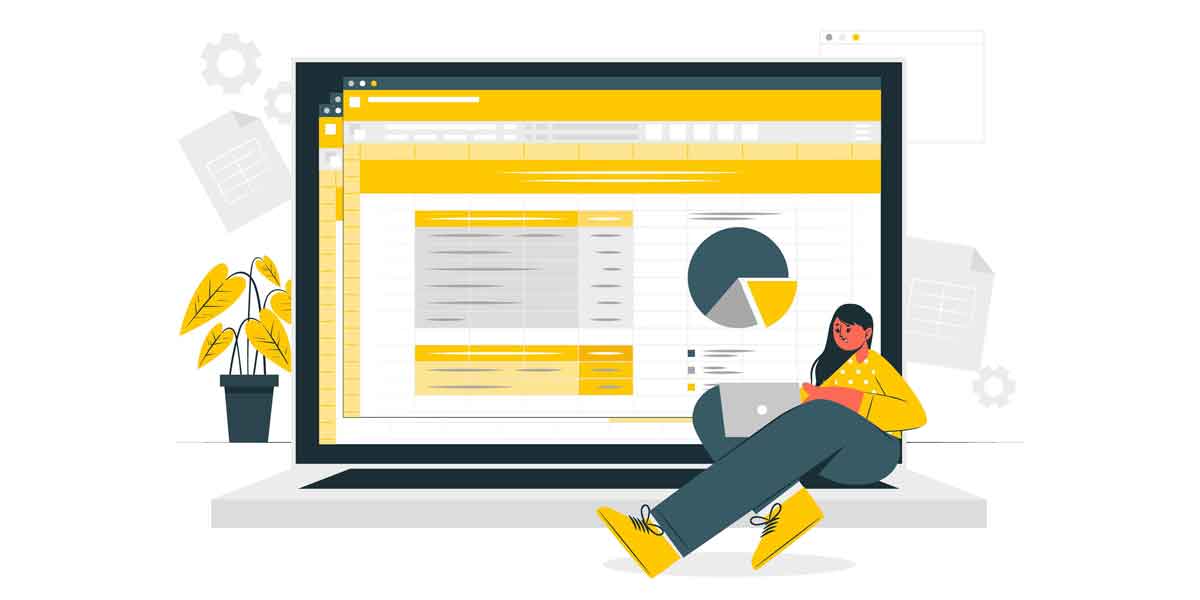What is a Financial Model?
A startup financial model is the numerical representation of a startup’s goals. And the process of building a financial model for a startup is termed as startup financial modelling. It consists of several steps, from gathering the key metrics and assumptions to helping the startups fundraise. A good financial model is a prerequisite for every startup before approaching VCs and HNIs for fundraising. Further, having a good financial model will also help startups build a sustainable financial future.
Importance of Startup Financial Modelling
- Financial modelling helps new entrepreneurs to find out whether they can turn their ideas into a sustainable operating business.
- It also helps startups quantify and validate their business plan and business models cost-effectively.
- It helps to get an idea about fund requirements when they are in need and the rate at which the business will possibly scale.
- Financial modeling shows the actual financial state of a startup. It also provides the investors with the proper insight into its real-time financial position.
Types of financial model
Most financial models focus on valuation. Whereas some other models focus on calculating and predicting risk, the performance of the portfolio, and economic trends. Following are the common corporate financial models that are relevant for startups;
- Three Statement Model: As the name suggests, this model links three statements. They are income statements, balance sheet,s and cash flow statements. In order to integrate them into one dynamically connected financial model using formulas in Excel. One of the main purposes of this model is to forecast the financial position of a company as a whole. Often this model is a base for models that are more complex like Discount Cash Flow Model, Merger Model, Budget Model etc.
- Budget Model: Budget Model focuses on the income statement. Usually, this model is prepare by considering the monthly or quarterly figures. This model mainly benefits business to compare their current performance with their future financing goals. Sales, expenses, cash flow, equity and asset replacement etc are some of the financial factors considered by this model. This also enables to perform the financial modelling in Financial Planning and Analysis (FP&A) to arrive at a budget for the succeeding years(usually one, three and five years).
- Forecasting Model: As the name implies, this model is to predict the possible outcomes relating various aspects like demand and supply, sales, consumer behaviour etc. This model sometimes uses the budget model to compare. After analyzing its output, both models groups into a single work book or sometimes they may arise to be entirely different.
- Discounted Cash Flow Model: The purpose of this method is to arrive at the present value of an investment/company or cash flow. It is done by altering future cashflows to the time value of money to reach the present value of an investment in a business. For this we have to consider multiple factors like inflation, risk and cost of capital to estimate the forecast free cash flows, which are further discounts back to the present fair value.
- Merger Model (M&A): The merger model determines whether a benefit exists from merging. It represents the analysis of two companies brought together through the M&A process. It determines the possible impact of two companies to get merge or one company taking over another. Two main steps in building a merger model include M&A model inputs, assumptions relating the model, model analysis and outputs.
Apart from the above five models, other types of the financial model include;
A)Initial Public Offering (IPO) Model: Financial professionals like investment bankers mainly use IPO Model for valuing their business before going public. Based on an assumption regarding how much investors would be willing to pay with regard to a company in contention, this model equates to the company analysis. And valuation as per this model includes an IPO discount to ensure better performance of stocks in the market.
B) Leveraged Buyout (LBO )Model: The LBO Model aims to evaluate leveraged buy out transactions, i.e., obtaining a company funded with significant debt. The main advantages of this model is that it helps investors assist the transaction and earn low risk internal rate of return (IRR). As an advanced form of the financial model, LBO requires debt schedules for doing the modelling. Some of the unique elements of an LBO model includes;
- A higher degree of support
- Multiple portions of debt financing
- Issuing of shares that prefer
- Management equity compensation
- Operational improvements aiming the business
C) Sum of the Parts Model (SOPT): As the name implies, this model blends numerous DCF models by adding them together. SOPT states the process of valuing each segment of a business and adding them up to get the total Enterprise Value (EV). Further, this model can also use in parallel with other techniques like Discounted Cash Flow modelling and comparable company analysis. This mode is not fitting for all business, but it’s very useful for;
- Companies having different business segment or divisions
- Companies having definite assets
- Conglomerates or holding companies with different companies
D) Consolidation Model: This model fuse several business models into one single model. This model groups the financial statements of two or more entities to build a secured financial statement. This type of model belongs to reporting model category of the financial model.
E) Forecasting Model: As the budget model, this model is also used in FP&A to do prediction that compares to the budget model. This type of model also belongs to reporting model category of financial modelling.
F) Option Pricing Model: The option Pricing model is part of the pricing model category of financial models. Two main types of option pricing models include binomial trees and Black-Sholes. This model is entirely based on mathematical financial modelling rather than specific standards.
Key Inputs To A Startup’s Financial Model
Following are the 6 main inputs to building a sound financial model for a startup;
- Revenue: Revenue serves as the first input that goes into a financial plan. For a startup, revenue forecast might be tricky as there have been no sales in the past. The revenue forecast is usually a combination of top-down and bottom-up methods. Forecasting revenue also depends on the business model. But for a SAAS platform, revenue forecasts based on existing customers, new customers and churn rates are much more suitable.
- Cost of goods sold (COGS): COGS includes all costs incurred by a company in delivering its products or services. And this will defer based on the company’s offerings. That means if the company sells tangible goods, COGS includes the cost of materials involved in manufacturing the product. But for a service-based company, COGS consists of the personnel costs for the employees delivering the same. Further, for a SAAS company, COGS covers hosting costs, onboarding and customer support costs and online payment costs. COGS forecast might sometimes depend on the business model. Forecasting the same based on a total level like a month might sometimes give more sense.
- Operating expenses (OPEX): The general expenses incurred by a business to run on daily basis are termed as operating expense. It include all costs associated with sales and marketing, research and development and general and administrative tasks. And preliminary expenses of a startup usually include legal fees, travel costs, costs relating to payroll, IT costs, office supplies insurance, patent cost etc.
- Personnel: Here, an analyst predicts the number of employees hired along with their respective salaries. It also includes the payroll taxes and perks provided, if any. To make this step easier, an analyst may split the personnel into different categories like;
- Direct labour: Includes all employees who solely engage in producing goods sold or services delivered.
- Sales & marketing: It includes employees who are part of the business such as sales managers, marketing managers, social media experts, copwriters etc.
- Research and development: These employees are also part of operating expenses and include R&D managers, software engineers, technicians etc.
- General and administration: These employees are also part of operating expenses and include back-office and C-level personnel like CEO, CMO, CFO, Secretaries etc. Further, to check whether the personnel forecast is realistic, divide projected revenues in a given year by the number of employees for that year. It will give an idea about the company’s revenue per employee. It also provide a basis for comparison with industry leaders.
- Investments in assets/ Capital expenditures: Capital expenditures or, in other words, investments in assets account to be the fifth input to a startup’s financial model. It denotes the fund utilization by a company to acquire or improve physical assets, infrastructure, intellectual property, buildings and other equipment. And these are incurred by a company to sustain or enhance the scope of its operations. For startups, such expenses include investments in computers, office equipment, machinery etc.
- Financing: Financing is the final input into a startup’s financial model. It includes financing streams such as equity, loans, or subsidies. This helps to know about the possible impact of the company’s funding need by adding different types of funding.
Four other supporting elements for a startup’s financial model
- Working capital: Working capital is the essential elements as it denotes both efficiency and its short-term financial health. It has a significant effect on the cash flow of a company. If a company’s current asset does not exceed current liabilities, then it can result in bankruptcy. Working capital usually appears on the balance sheet and is calculated based on the number of days the company’s sales and payable are outstanding and the number of days the company holds its inventory before selling it. Thus financial model should essentially include a sheet for calculating the working capital based on revenues, COGS and days outstanding.
- Depreciation: Value reduction in a company’s assets is commonly termed as depreciation. It is calculated based on an asset’s value and its useful lifetime. It appears on the P&L and has an impact on the value of assets on the balance sheet.
- Taxes: Every company is obliged to pay yearly taxes on its financial results, commonly termed corporate income tax. To include tax carryforwards into financial models, a separate tax scheme is required for the model.
- Valuation: The purpose of every startup building a financial model is for fundraising. And the process mainly includes negotiations with investors regarding the company’s valuation to be invested in. Most startups are valued using Discounted Cashflow Method (DCF). And this method estimates the value of a company based on its future performance. This method best suits for startups because they have not yet realized any historical performance but expect good earnings in the future. But the main downside of this method is that valuation through this method is highly sensitive to the input variables used to calculate the valuation.
How to build a financial model for startups?
There are mainly two approaches to building an effective financial model for a startup, namely;
- Top-Down Approach: This approach estimates the company’s future performance, starting from market data and working down to revenue. Here an analyst will first determine the total market value of the product and narrow it down to a particular location. And based on the assumption that the product will capture a distinct portion of the target market and further use this estimate to arrive at a sales forecast. Thus in this approach, the forecast is done by considering the market share that the startup is planning to capture within a specific timeframe. And in this approach use mainly the TAM SAM and SOM model. TAM SAM SOM model considers market size at three different levels;-
- Total Available Market (TAM) defines the total market demand for the product or service.
- Serviceable Available Market (SAM) – Serviceable Available Market is that part of TAM that represents the niche market for the product within the geographical area.
- Serviceable Obtainable Market (SOM) – SOM is that part of the market that the business can capture. Thus SOM represents the sales target since it represents the share of the market that the company aims to capture.
Once the sales target is defined using the TAM SAM SOM model, the next step is to calculate all costs associates with manufacturing and delivering the products or services . Also forecast all expenses relating to various aspects like sales, marketing, general and administrative tasks for the business to run sustainably. And all these costs should not exceed the revenue targets to arrive at a positive EBITDA.
- Bottom-Up Approach: This approach considers business-by-business or sector-by-sector fundamentals. Thus helps an analyst identify the profitable opportunities for a startup and perform its valuation compared to the market.
What are the possible outcomes of a startup’s financial model?
The three main possible outcomes of a startup’s financial model are as follows;
- Financial statements: A sound financial model must essentially include a forecast of three financial statements, i.e. the profit & loss statement (P&L), the balance sheet(BS) and the cash flow statement(CF). And these statements are used to communicate the financial information across various stakeholders like banks, investors, governments, and others interested in understanding the financial performance of a firm or startup. P&L gives insights into all incomes and expenses generated by a company over a specific period of time and indicates whether the business is profitable or not. Whereas the balance sheet gives details about everything that the company owns and owes at a specific time. Further, a cash flow statement shows the information on all cash inflows and outflows of a company. It consists of three different parts; Operational cash flow, investment cash flow and financing cash flow. Operational cash flow denotes cash inflow and outflow relating to core business operations. Investment cash flow shows cash flow resulting from investment activity. Whereas financing cash flow means cash changes resulting from financing activities.
- Operational cashflow overview: It is good to forecast the financial statements every year for fundraising. But for the financial management of a company on a daily basis, it is helpful to include operating cash flow for the coming 12 months in the financial model. To create an operational cash flow forecast, list out all categories of cash inflows and outflows, add a starting balance and check what remains at the end of every month.
- KPI overview: Another common output of a startup’s financial model typically includes Key Performance Indicators (KPIs) of some companies or KPIs relating to specific sectors. KPI is not only important for investors, but it might also be necessary for company owners. These metrics can track company performance, experiments relating to different acquisition channels, cost structures, business models etc. Further, KPIs can be of different types like KPIs showing sales and profitability, cashflows and raising investments or even KPIs that are specific to a company or industry.
Related Topics: How Financial model can help startups raise funds , How Financial Model helps startups avoid common pitfalls
Elevate Your Startup With Our Expert Financial Modelling Solutions
Ready to propel your startup’s funding journey with precision? Our financial modelling services are designed to navigate complexities, fuel growth, and attract investors. From projections to insights, we craft models that speak your startup’s language. Elevate your financial strategy – explore our expert financial modeling services today!






